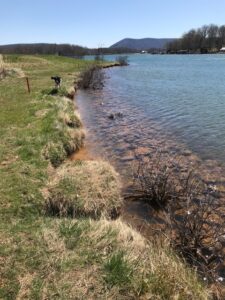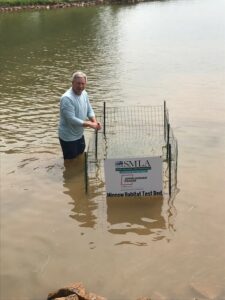06 Feb Demonstration Buffer Garden
SMLA, Mariner’s Landing and APCO Join Hands to Create a Demonstration Buffer Garden
What is a buffer garden? Why do you need one? What plants should be used? What does it cost? For years, the Smith Mountain Lake Association (SMLA) and Appalachian Power Company (APCO) have touted the attributes of buffer gardens along shorelines for their ability to impede the flow of fertilizer, pollutants, and sediment runoff into SML. Yet, many of our residents don’t appreciate what a buffer garden can do, what one looks like, or how it is designed. SMLA’s Buffer Landscaping Advisory Support Teams visit about 25 properties each year to offer free advice about buffer gardens and suggest opportunities to “slow the flow”. These visits are praised highly, but SMLA needed a visible, open-to-the-public demonstration garden site to better illustrate buffer gardens and educate our waterfront residents.
In 2019, SMLA submitted a grant proposal to APCO requesting funding for the installation of a buffer garden pilot project that would demonstrate appropriate buffer garden design, proper plant selection and potential cost for lake residents. Accessible to all, this demonstration garden provides a great example of shoreline restoration an opportunity to learn buffer garden techniques. APCO accepted this proposal and awarded a grant to SMLA to implement this project. Multiple sites, including shorelines next to APCO/Department of Wildlife Resources (DWR) public boat ramps, were considered, however the Mariners Landing Country Club’s 5th hole/green tee was ultimately approved for the buffer garden site. APCO owns the land that the golf course leases, and this tee/green location is visible to not just golfers but boaters, residents and visitors as well. Conditions at the tee box had become unsightly with overgrown vegetation causing sightline impairment from the adjacent “black” tee. Over the past 40 years, significant shoreline erosion had allowed degradation of the lake water surrounding the tee box. Increased runoff, likely containing fertilizer, was entering the lake.
COVID restrictions slowed progress on project planning during 2020 and 2021, but with easing concerns, productive discussions between John Rupnik, SMLA’s Buffer Landscape Committee Chair, and Waller Perrow of Mariners Landing ensued. Immediately recognizing the positive environmental impact of this effort, Perrow offered support to do the entire 5th hole! Thus, a collaborative project began that would indeed be of great value to Smith Mountain Lake. However, it would require significant resources to survey, remove the existing vegetation, grade the shoreline, install new riprap, prepare the soil, purchase native plants and distribute mulch along more than 1,000 feet of shoreline. Perrow is currently seeking willing partners, sponsors and stakeholders to help fund this project.
To assist with these challenges, Rupnik contacted the Peaks of Otter Soil and Water Conservation District to inquire about their Virginia Conservation Assistance Program (VCAP). Offered through the Virginia Association of Soil and Water Conservation Districts (VASWCD), this program provides financial, technical and educational assistance to property owners installing eligible stormwater control practices. For this type of buffer project, VCAP may provide limited funding to prepare the land and purchase native vegetation in the buffer garden. Rupnik and Tracy Culbertson from Peaks of Otter conducted a site survey, swapped ideas, and formulated a path forward resulting in an optimistic outlook for VCAP funding. Perrow plans to submit the VCAP application as estimated total costs are assembled.
Since most of the property is below the 800’ contour, APCO’s Shoreline Management Plan rules apply. Eli Meador from APCO was consulted on the project goals, and he stated that a Vegetation Removal Permit and a Shoreline Stabilization Permit would be required. APCO permits that allow vegetation removal and disposal require replanting, and that only plants native to Virginia are to be proposed. ACCUPOINT Surveying and Design conducted both the land survey and the landscape design. SMLA Master Gardeners and Master Naturalists volunteered to comment on native plants selected and recommend species that would be better suited to this picturesque golf course/lake view setting. ACCUPOINT also included key VCAP application land preparation and vegetation requirements to ensure the design product responded to both VCAP as well as APCO. With these diligent efforts by ACCUPOINT and a quick turnaround by Meador and APCO, the permits were approved in early December 2022.
Construction efforts have begun. Mariner’s Landing greens keeping staff removed the existing, unsightly shoreline vegetation just prior to the new year. Shoreline grading should commence soon followed by installation of new riprap. Rupnik and Perrow expect soil preparation, native planting and mulching to occur in late March or early April.
In addition to supporting the buffer garden, the initial APCO grant was conditioned on the planting of underwater plants near the project shoreline to support fish habitat. Very little underwater vegetation currently exists in SML and planting is intended to help nursery habitat for baitfish and popular sporting fish species. Ten years ago, 5,000 triploid sterile grass carp were released into the lake to consume non-native, invasive hydrilla that was clogging many coves. While the carp were extremely efficient in dealing with the hydrilla, these fish didn’t discriminate between nuisance weeds and beneficial plants, and they almost rid the lake of submerged vegetation. This past summer, SMLA volunteers, after a coaching session by Dan Wilson of DWR, harvested water willow, a native shoreline plant growing elsewhere on the lake, and planted a test bed in the cove that bisects the 5th hole. Rupnik used a wire cage to protect the water willow from the sterile grass carp that should be nearing the end of their anticipated lifespan. This coming growing season, Rupnik will remove the cage, reposition the cage and plant additional water willow. He will assess if the grass carp are still feeding on the plants from the original plot. If so, then the new water willow plot will be uncaged next year for further feeding assessment. If not, native water willow will have opportunity to grow and expand in the shallow water providing shelter for small fish. By meeting the conditions of the APCO grant, the SMLA also can assess the status of the sterile grass carp.
Rupnik and Perrow plan to place instructive, informative signs on the 5th hole describing the project purpose and its positive impact on Smith Mountain Lake. The SMLA and Mariner’s Landing websites will have links to a full explanation of the process, plant selection, and nominal cost per 100 feet of buffer. Rupnik also hopes for future collaborations with other lakefront golf communities to better protect the lake from algae blooms. It’s worth mentioning that VCAP participation is eligible to public, private, non-profits and commercial landowners within the Peaks of Otter Soil and Water Conservation District service area. Hopefully, this might incentivize residents and significantly increase the number of buffer gardens on our shorelines and contribute significantly to clean lake water.
The mission of the Smith Mountain Lake Association is to protect the water of SML and promote safe recreation. Our all-volunteer, non-profit organization has been working on this mission for over 50 years, because we believe that clean, clear, safe water is a responsibility not an automatic right. If you would like to see more about what we’re doing, please visit our website at www.smlassociation.org or join us on Facebook.





